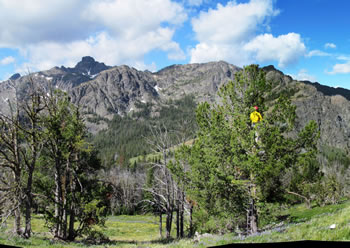Reforestation and Genetics
 Collecting whitebark pine seed for conservation and reforestation..
Collecting whitebark pine seed for conservation and reforestation..
Forest Service genetics needs have changed dramatically over the years, evolving from a focus on tree improvement for enhanced growth to today’s broader emphasis on genetic resource management, genetic conservation, and ecosystem sustainability and health.
Through all these changes, the procurement of seed and production of high quality material for reforestation and restoration remains the central mission of the Forest Service genetics program. This work is spread across numerous species, expanding in recent years to include non-commercial conifer and hardwood tree species as well as native shrubs, grasses, and forbs. Genetics expertise and knowledge is vital to the success of reforestation and restoration activities. Critical work includes:
- Developing and applying seed zones and seed transfer guidelines to ensure adaptability and resiliency for successful reforestation and restoration projects. This work is taking on a new and expanded emphasis in light of concerns over impacts of climate change on forest and range ecosystems.
- Combating invasive pathogens and insects through development of genetically resistant planting stock for high priority species and populations.
- Recommending appropriate species and seed sources for outplanting.
- Forecasting seed needs and directing seed procurement and production activities.
- Developing and implementing genetic conservation strategies for at-risk species.
- Providing training in seed procurement and genetic resource management.
- Managing seed orchards, breeding orchards, genetic test sites, and gene banks.

